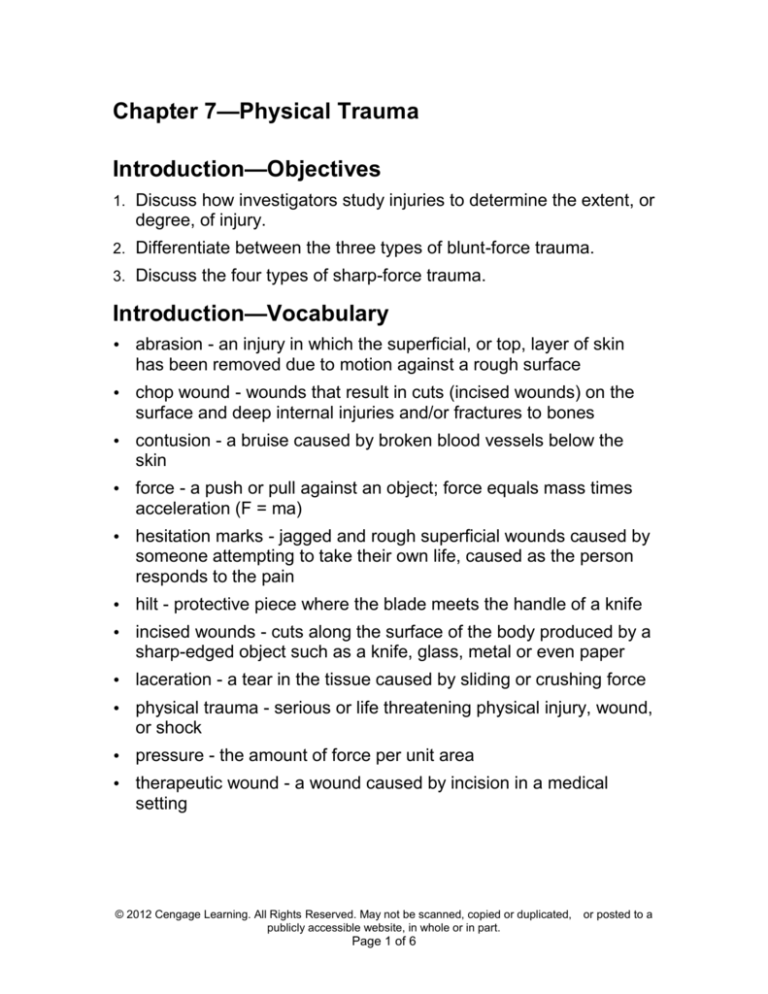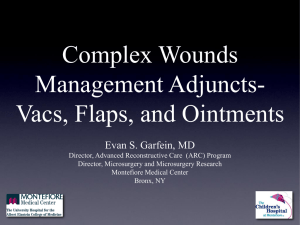
Chapter 7—Physical Trauma
Introduction—Objectives
1. Discuss how investigators study injuries to determine the extent, or
degree, of injury.
2. Differentiate between the three types of blunt-force trauma.
3. Discuss the four types of sharp-force trauma.
Introduction—Vocabulary
abrasion - an injury in which the superficial, or top, layer of skin
has been removed due to motion against a rough surface
chop wound - wounds that result in cuts (incised wounds) on the
surface and deep internal injuries and/or fractures to bones
contusion - a bruise caused by broken blood vessels below the
skin
force - a push or pull against an object; force equals mass times
acceleration (F = ma)
hesitation marks - jagged and rough superficial wounds caused by
someone attempting to take their own life, caused as the person
responds to the pain
hilt - protective piece where the blade meets the handle of a knife
incised wounds - cuts along the surface of the body produced by a
sharp-edged object such as a knife, glass, metal or even paper
laceration - a tear in the tissue caused by sliding or crushing force
physical trauma - serious or life threatening physical injury, wound,
or shock
pressure - the amount of force per unit area
therapeutic wound - a wound caused by incision in a medical
setting
© 2012 Cengage Learning. All Rights Reserved. May not be scanned, copied or duplicated, or posted to a
publicly accessible website, in whole or in part.
Page 1 of 6
The Siren and the Slugger
Rihanna and Chris Brown
A verbal argument erupted into a physical confrontation
Brown caused contusions to form on Rihanna’s forehead, left
hand, left triceps
He bit two of her fingers
Brown turned himself in, pled guilty to felony assault
Introduction
Physical trauma—any serious or life-threatening physical ingury,
wound, or shock
Blunt force trauma—when a victim hits or is hit by a hard object
Sharp-force trauma—when the victim is poked, cut, or stabbed by
something sharp
Evidence of Physical Trauma (Obj 7.1)
The amount of force applied
The weapon’s surface area and mass
The body part affected
Force
Force = mass x acceleration
Force is a push or pull applied to an object
Surface Area and Pressure
Pressure = force / surface area
Pressure is the amount of force per unit area
A weapon with a larger surface area will inflict a less severe injury
•
•
High-heeled shoe
Ping Pong paddle
© 2012 Cengage Learning. All Rights Reserved. May not be scanned, copied or duplicated, or posted to a
publicly accessible website, in whole or in part.
Page 2 of 6
Blunt-Force Trauma (Obj 7.2)
Abrasions
Contusions
Lacerations
Blunt-Force Trauma—Abrasions
Skin has three layers
•
•
•
Epidermis
Dermis
Hypodermis
Abrasion affects the epidermis, or outer layer
Shallow wounds that heal quickly
Blunt-Force Trauma—Abrasions
Brush Abrasions
•
•
When force is applied
parallel to the skin
Example: dragging the body
Blunt-Force Trauma—Abrasions
Impact Abrasions
•
•
•
When force is applied perpendicular to the skin
Crushes the skin
Common over bony parts of the body
Patterned Abrasions
•
•
When the impact of an object leaves an imprint on the skin
Patterns can be used to identify the weapon
Blunt-Force Trauma—Contusions
Also known as a bruise
A trauma caused by broken blood vessels below the skin’s surface
Hematoma—when contusions swell
Subdural hematoma— swelling below the brain’s outer membrane
Patterned contusions
© 2012 Cengage Learning. All Rights Reserved. May not be scanned, copied or duplicated, or posted to a
publicly accessible website, in whole or in part.
Page 3 of 6
Subdural Hematoma
Blunt-Force Trauma—Contusions
Contusions on internal organs are not visible externally
Skin pigmentation makes detection more difficult
Obese vs. athletic bodies
Children and seniors
Alcoholics
Blunt-Force Trauma—Lacerations
A tear in the tissue caused by an extreme sliding or crushing force
•
•
•
Blunt objects
A fall
Vehicle impacts
Lacerations may be internal or external
Irregular edges
Blunt-Force Trauma—Defensive & Offensive
Wounds
Defensive wounds—usually occur on the hands, writs, and arms
Offensive wounds—injuries to the perpetrator
These wounds help substantiate claims by the victim and
perpetrator
Sharp-Force Trauma (Obj 7.3)
Stab Wounds
Incised Wounds
Chop Wounds
Therapeutic Wounds
© 2012 Cengage Learning. All Rights Reserved. May not be scanned, copied or duplicated, or posted to a
publicly accessible website, in whole or in part.
Page 4 of 6
Stab Wounds
Most are caused by single-edged kitchen, pocket, or folding knives
Blade is usually 4-5 inches long
A sharp knife requires very little force
Hesitation marks—by suicide victims
Penetrating wound—puncturing the organ
Perforating wound—passes all the way through the organ
Stab Wounds
Incised Wounds
Produced by sharp-edged objects such as knife, glass, metal
Longer than deep
Force usually applied parallel to the skin
Do not provide clues to the type of weapon
Clean edges
Chop Wounds
Heavy tools—axes, machete, meat cleavers
Incised wounds on the surface
Deep internal injuries
Bone fractures
Characteristics of the wound help narrow down the possible type
of weapon used
Therapeutic Wounds
Caused by surgery or other medical procedures
Avoid confusion between therapeutic and inflicted wounds
© 2012 Cengage Learning. All Rights Reserved. May not be scanned, copied or duplicated, or posted to a
publicly accessible website, in whole or in part.
Page 5 of 6
Chapter Summary
The extent of the physical trauma depends on
•
•
•
•
the amount of force applied to the body,
the part of the body affected,
how much of the body’s surface was affected, and
the type of weapon used
Force is equal to mass times acceleration.
The more massive the weapon, the greater the force exerted on
the body.
The more the weapon is accelerating upon impact, the greater the
force exerted on the body.
Pressure is equal to force divided by surface area. Assuming that
the force is equal, a weapon with a smaller surface area will exert
greater pressure than a weapon with a larger surface area.
Abrasions are blunt-force trauma caused when the top layers of
skin are damaged.
Contusions are broken blood vessels caused by blunt force and
are commonly called bruises.
Lacerations are tears in tissue caused by sliding or crushing blunt
force.
Stab wounds—
•
•
•
Incised wounds, or cuts, are
•
•
•
sharp-force trauma caused when
a sharp object is forced along the body
wounds tend to be wider than they are deep
Chop wounds—
•
•
•
•
a sharp-force trauma
deeper than they are wide
force is applied toward the body
sharp-force trauma
caused by sharp, heavy objects
incised wounds on the surface, and
deep internal injuries, often including broken bones.
Therapeutic wounds—result of surgery
© 2012 Cengage Learning. All Rights Reserved. May not be scanned, copied or duplicated, or posted to a
publicly accessible website, in whole or in part.
Page 6 of 6









